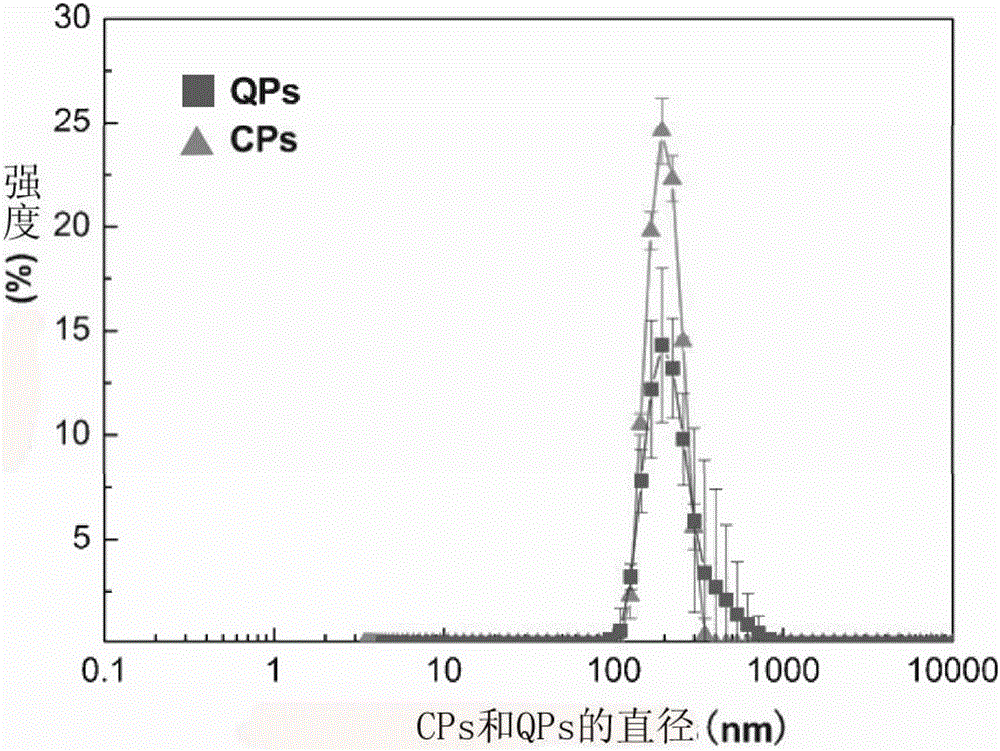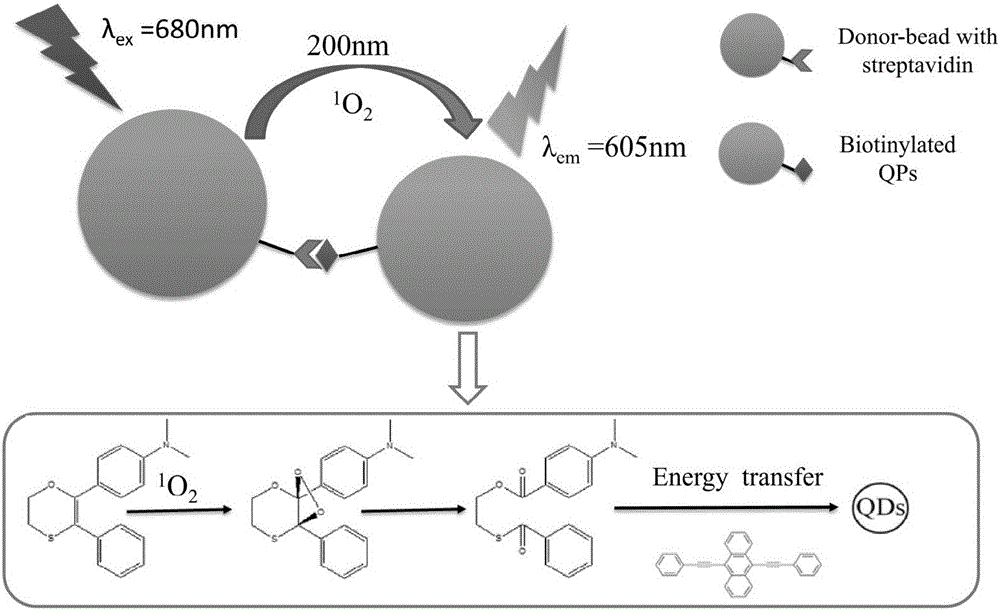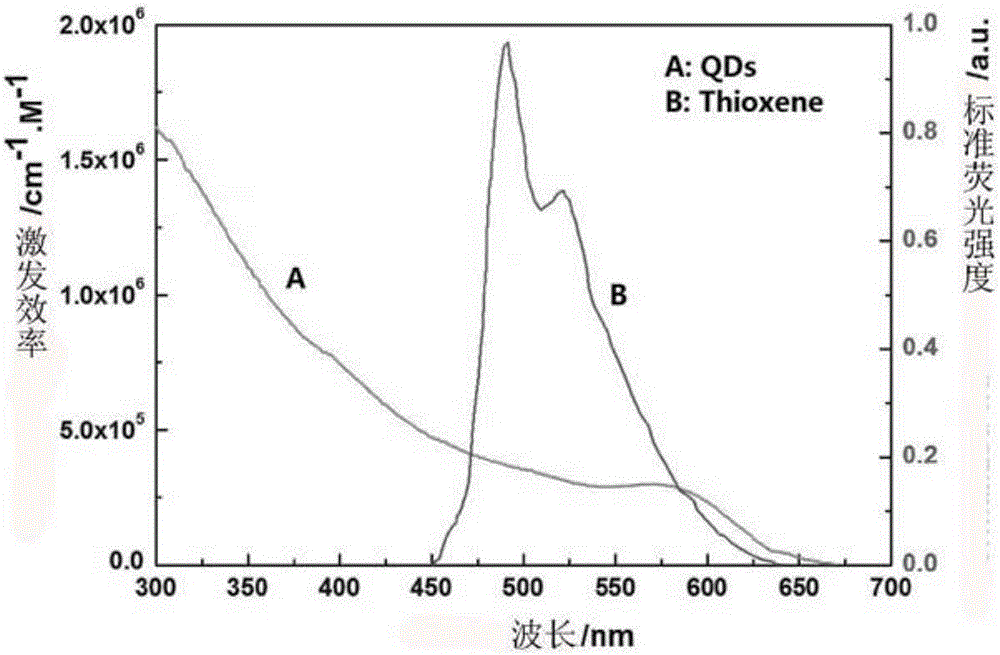Carcino-embryonic antigen immunization analysis method based on singlet oxygen channel light-emitting quantum dot sensor
A carcinoembryonic antigen and immunoassay technology, applied in the field of immunodetection, can solve the problems of near-infrared sensitive detector requirements still existing, no more than 10nm, spectral width, etc.
- Summary
- Abstract
- Description
- Claims
- Application Information
AI Technical Summary
Problems solved by technology
Method used
Image
Examples
Embodiment 1
[0051] The core technology of this step is to obtain symmetrical water-soluble quantum dots with high quantum yield and narrow maximum half-maximum width of the fluorescence emission peak. The concrete implementation of the present invention used is the core / shell type cadmium selenide / zinc sulfide quantum dot purchased from U.S. Invitrogen Company, and its solvent is decane, and its spectral Stock shift length is from 592nm to the wider range between short wavelength Therefore, the quantum dot can be excited with a wavelength shorter than 592nm; the fluorescence emission peak is 605±0.5nm, the maximum half-peak width is 27±1.5nm, and the quantum yield is 76%; Oxygen-receiving "antenna" thiazine compound has a matching fluorescence emission spectrum, overcomes the shortcomings of organic dyes in all aspects, and is suitable for replacement to reduce measurement errors, improve fluorescence resonance energy transfer (FRET) efficiency, and improve analytical sensitivity.
[0052...
Embodiment 2
[0062] A carcinoembryonic antigen immunoassay method based on singlet oxygen channel luminescence quantum dot sensor, comprising quantum dot nano hydrosol and functional photosensitive microsphere; the preparation method of quantum dot nano hydrosol and functional photosensitive microsphere is as follows:
[0063] 1. Preparation of high-performance water-soluble quantum dots: put 50 μL of fat-soluble quantum dots in a centrifuge tube, add 200 μL of anhydrous methanol; mix well, seal the centrifuge tube, centrifuge at 3000 rpm, 4 ° C for 5 min; discard the supernatant Add 40 μL of chloroform to fully dissolve; add 21 mg of glutathione stabilizer and 10 μL of 0.1M sodium hydroxide aqueous solution, mix well, shake and incubate on a shaker, and store at room temperature for 2 hours; add 100 μL of deionized water and 1.8 mL of acetone, precipitated, centrifuged at 6000 rpm for 5 min; dissolved in 0.5 mL of deionized water to obtain water-soluble quantum dots. The emission spectrum...
Embodiment 3
[0068] Based on the application of singlet oxygen channel luminescent quantum dot sensor in the analysis of homogeneous oxygen transfer fluorescence resonance energy transfer, the principle of homogeneous analysis of singlet oxygen channel luminescent quantum dot sensor is as follows image 3 As shown, the steps to apply are as follows:
[0069] 1. Conjugate TQPS with anti-carcinoembryonic antigen monoclonal antibody, the steps are as follows: prepare 0.5M MES buffer, adjust pH to 6.1, take 100 μL for use; prepare 50 mg / mL Sulfo-NHS solution with deionized water, take 230 μL Stand-by; prepare 50 mg / mL EDAC solution with deionized water, take 240 μL for use; mix the above solution for use, dilute to 1 mL with deionized water, add to the TQPS prepared in the above step 3, and resuspend; the mixture is at room temperature Shake the reaction for 30 minutes; centrifuge at 16000rmp to remove unreacted Sulfo-NHS and EDAC, wash with deionized water, resuspend, and centrifuge three tim...
PUM
| Property | Measurement | Unit |
|---|---|---|
| emission peak | aaaaa | aaaaa |
| molecular weight | aaaaa | aaaaa |
| wavelength | aaaaa | aaaaa |
Abstract
Description
Claims
Application Information
 Login to View More
Login to View More - R&D
- Intellectual Property
- Life Sciences
- Materials
- Tech Scout
- Unparalleled Data Quality
- Higher Quality Content
- 60% Fewer Hallucinations
Browse by: Latest US Patents, China's latest patents, Technical Efficacy Thesaurus, Application Domain, Technology Topic, Popular Technical Reports.
© 2025 PatSnap. All rights reserved.Legal|Privacy policy|Modern Slavery Act Transparency Statement|Sitemap|About US| Contact US: help@patsnap.com



